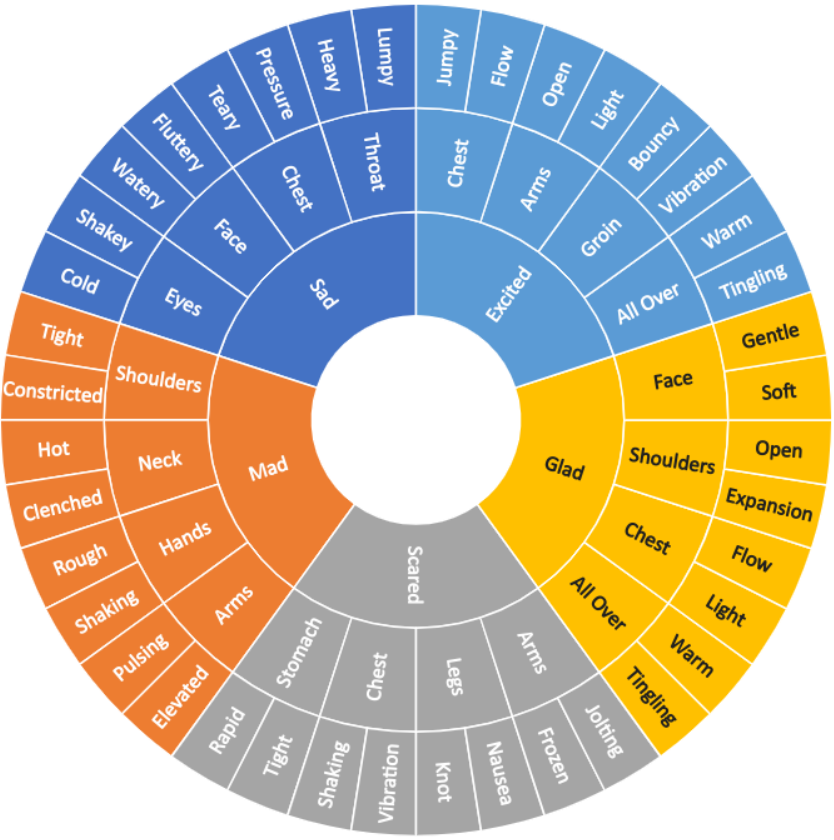By Brian Danziger, MA, LPCC
What Are Emotions?
You can think of emotions as biological signals your body is trying to communicate with you to help you better understand and process your experience. Because emotions are stored in the body, to fully receive and integrate these signals, we need to feel them. Feeling your feelings can be as easy as bringing your awareness to the sensations inside your body and allowing them to exist. When you make connections and listen to your emotions you can use their messages to better understand yourself, your experience, and your truth.
The 5 Basic Emotions:
Mad, Sad, Glad, Scared, Excited!
These are the 5 primary emotions that all have a physiological reaction in the body. While other emotions exist, they are often a spectrum of these basic emotions. For instance, frustrated and enraged both mean “mad”, but they are on opposite ends of the mad spectrum. Other emotions outside of the basic 5 can also have a heavy thought component like guilt, which is often associated with thinking “I did something wrong”. Keeping it simple with the 5 basic emotions allows you to stay with the emotion in your body, rather than going to your head to “properly” label or identify it.
Where Emotions Reside In The Body
Generally speaking, emotions tend to reside in specific areas of the body due to their biological and evolutionary purpose. That being said, where your emotions reside in your body is unique to you and your body. When trying to identify where your emotions are in the body you can do a quick body scan to see what parts of your body are activated and feeling sensation. Doing a top-down scan of head to feet (head, neck, throat, back, shoulders, arms, hands, chest, stomach, groin, legs, feet) can be really helpful in connecting to your body and where you are feeling sensation. Below is a chart created to show what parts of the body are typically activated when we feel specific emotions.
Sensations
Sensations are how we detect energy from our internal or external environment and code it as (neural) signals for our brains to interpret. Our perception, or awareness, of these sensations allows us to process these emotions and recognize the meaning and data that they are trying to share with us. While the most important thing is staying with your emotion, labeling it and using sensation words allows you to become more familiar with the emotion and how it is showing up in your body. The more familiar you are with your emotions, the less intimidating they are! If using sensation words feels too difficult, you can also try labeling these emotions on spectrums (pleasant to unpleasant, warm to cold, fluid to stagnant, sharp to dull, etc.) Below is a list of sensation words that you can use to help better understand the physical feelings in your body!
Bringing It All Together
Below is a Somatic Feelings Wheel, to help you better understand and meet your emotions. The first ring of the chart is the five basic emotions. The second ring of the chart is where those emotions and sensations reside in the body. The final ring of the chart is a list of words to help describe the sensations you are feeling in your body. To utilize the chart, identify which of the 5 basic emotions you are feeling, identify where in your body you are feeling activation, and finally use the sensation words to help describe the emotion in your body. From there see if you can breathe into the sensation and hold your awareness to it as it shifts and transforms through your body.
Experiential Exercise:
Recognizing Emotion
Take a moment to take a few deep breaths and bring your attention to your internal experience. See if you can make contact with the sensations that you are experiencing inside your body. If it feels safe, breathe into the sensations that you are feeling, and stay with them for a minute.
Try to name the sensations, and if you are struggling to do that you can use the last ring of the chart, or use the sensations table shown above.
Once you've identified the sensation, you can name where you are feeling it in your body. If the intensity, location, or sensation changes, just try to keep your awareness on it without judgment.
Now that you’ve identified the sensation, see if you can label what emotion this is (mad, sad, scared, joy, excitement). If you are unable to label this emotion at this time, that is okay, just stick with the sensation. Keeping your awareness focused on the sensation, see if you can label where it lands on the spectrums below, taking a few deep breaths between each line:
As this experiential exercise comes to a close, take a moment to thank yourself for connecting to your body and your emotions.
Exercises like this one can be easier and more meaningful if you have someone to guide you through it. All of our therapists are trained to help you tune into your emotions and the sensations in your body. Your body has much to teach you if you will let it!
If you would like a therapist to help you with an exercise like this, please contact us at info@evolveinnature.com.






